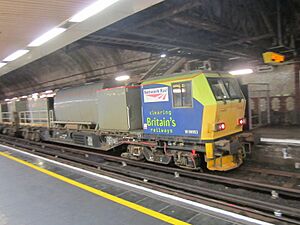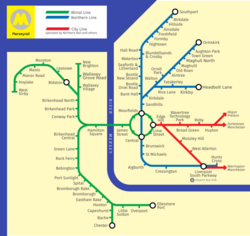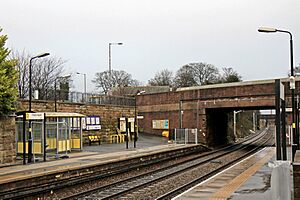Merseyrail facts for kids
Quick facts for kids Merseyrail |
|||
|---|---|---|---|
777010 at Hooton Station 20210728-1.jpg |
|||
| Info | |||
| Owner | Merseytravel, Network Rail | ||
| Locale |
|
||
| Transit type | Commuter rail | ||
| Number of lines | 2 (plus main line commuter services) | ||
| Number of stations | 69 (67 managed ) | ||
| Chief executive | Neil Grabham | ||
| Headquarters | Rail House, Liverpool | ||
| Operation | |||
| Began operation | 1886 as the Mersey Railway, 1977 as expanded Merseyrail | ||
| Operator(s) | Merseyrail Electrics 2002 (Serco and Transport UK Group) | ||
| Number of vehicles | 53 | ||
| Train length | 4 cars, 8 cars during peak times | ||
| Headway | 15 minutes (general), 5 minutes (central sections), 30 minutes (Ellesmere Port branch, general in evenings and on Sundays) | ||
| Technical | |||
| System length | 122 km (76 miles) | ||
| Track gauge | 4 ft 8 1⁄2 in (1,435 mm) standard gauge | ||
| Electrification | 750 V DC third rail | ||
|
|||
Merseyrail is a train network that helps people travel around the Liverpool City Region in the North West of England. It's a bit like a subway or metro system, but for a whole region.
The modern Merseyrail network started in 1977. Old railway lines were connected by building new tunnels under the centre of Liverpool and Birkenhead. This made it much easier for people to get around.
Today, Merseyrail has 69 stations and two main lines: the Northern line and the Wirral line. The trains are electric and run on special tracks. About 6.5 miles of the track are underground in tunnels. The network uses modern Class 777 trains. In the 2023/2024 year, people took 28.3 million trips on Merseyrail.
Contents
The Merseyrail Network
The Merseyrail network is mostly self-contained, meaning its trains usually stay on their own lines. It is run by a company called Merseyrail Electrics 2002, which is a team-up between Serco and Transport UK Group. The whole system is managed by Merseytravel, the group in charge of public transport for the Liverpool area.
The network has two main electric lines, the Northern line and the Wirral line. Trains on these lines usually run every 15 minutes. They connect the centre of Liverpool with towns like Southport, Chester, and Ormskirk.
There is also a third line called the City line. It is shown in red on the map. Other companies like Northern Trains run the trains on this line, but it is still part of the Merseyrail family.
You can switch between the lines at these main stations:
- Northern and Wirral lines: Change at Liverpool Central and Moorfields.
- Wirral and City lines: Change at Lime Street.
- Northern and City lines: Change at Liverpool South Parkway and Hunts Cross.
Northern Line
 The Northern line is shown in blue on maps. It has three main routes:
The Northern line is shown in blue on maps. It has three main routes:
- From Hunts Cross to Southport.
- From Liverpool Central to Ormskirk.
- From Liverpool Central to Headbolt Lane.
Trains run every 15 minutes on each route, so if you are travelling in the central part of Liverpool, a train comes along very frequently.
When there are football matches at Goodison Park or Anfield, a special "SoccerBus" service runs from Sandhills station to take fans to the stadiums.
Wirral Line
 The Wirral line is shown in green on maps. It connects Liverpool with the Wirral Peninsula. Trains start from four places: Chester, Ellesmere Port, New Brighton, and West Kirby.
The Wirral line is shown in green on maps. It connects Liverpool with the Wirral Peninsula. Trains start from four places: Chester, Ellesmere Port, New Brighton, and West Kirby.
All trains on this line go through a tunnel under the River Mersey. They then travel around a loop of track under Liverpool's city centre before heading back to the Wirral. This loop means trains run every 5 minutes in the centre of Liverpool.
City Line
The City line is shown in red on maps. These services start from the main platforms at Liverpool Lime Street. They travel to stations in the Liverpool City Region and beyond.
Even though other companies operate the trains, Merseytravel uses the Merseyrail brand for the City line. This helps give the whole network a single identity. Unlike the other two lines, some City line routes use diesel trains instead of electric ones.
A Brief History of Merseyrail
The story of Merseyrail began in the 1800s with the Mersey Railway. This company built one of the world's first underwater railway tunnels, which runs under the River Mersey.
The modern network was created in the 1970s. Before then, many different companies ran the local railways. In the 1960s, many train lines around the country were closed. But in Liverpool, leaders decided to save and improve the local lines. They connected them with new tunnels under the city centre, creating the single Merseyrail network we know today.
Since then, new stations have been built, like Maghull North in 2018 and Headbolt Lane in 2023. There are plans to keep improving the network, including reopening St James Station, which will be called Liverpool Baltic.
Train Services
You can buy tickets at station offices or from machines. Merseyrail is also part of the local "MetroCard" smartcard system, which you can use on buses and ferries too.
Here is a list of the usual train services on weekdays:
| Northern line | ||
|---|---|---|
| Route | tph | Calling at |
| Hunts Cross to Ormskirk | 4 |
|
| Liverpool Central to Southport | 4 |
|
| Liverpool Central to Headbolt Lane | 4 |
|
| Wirral line | ||
| Route | tph | Calling at |
| Liverpool Central to New Brighton | 4 |
|
| Liverpool Central to West Kirby | 4 |
|
| Liverpool Central to Chester | 4 |
|
| Liverpool Central to Ellesmere Port | 2 |
|
The Trains on Merseyrail
Class 777: The New Fleet
Merseyrail's new trains are called Class 777. They were built by a company called Stadler Rail in Switzerland. These trains were designed just for the Merseyrail network.
The new trains have four connected cars, which means more space for passengers. They are also lighter and use less electricity, which is better for the environment. They can speed up and slow down faster, making journey times shorter.
A cool feature of these trains is that they can be fitted with batteries. This allows them to travel on parts of the track that don't have the electric third rail. This technology is already used to run trains to the new Headbolt Lane station. It could allow Merseyrail to expand to new places in the future.
The first Class 777 train started carrying passengers in January 2023. They were gradually introduced across the whole network.
Current Fleet
| Class | Image | Type | Top speed | Number | Carriages | Routes operated | Built | In service | |
|---|---|---|---|---|---|---|---|---|---|
| mph | km/h | ||||||||
| 777 METRO |  |
EMU BEMU |
75 | 120 | 53 | 4 |
|
2018–2021 | 2023–present |
Past Fleet
Before the new Class 777 trains arrived, Merseyrail used Class 507 and Class 508 trains. These trains served the network for over 40 years, starting in the late 1970s.
They were very reliable, but they were replaced by the modern Class 777s. The last of the old trains were withdrawn from service by the end of 2024.
| Class | Image | Type | Top speed | Carriages | Number | Routes operated | Built | Withdrawn | |
|---|---|---|---|---|---|---|---|---|---|
| mph | km/h | ||||||||
| 507 |  |
EMU | 75 | 120 | 3 | 33 |
|
1978–1980 | 2022–2024 |
| 508 |  |
EMU | 75 | 120 | 3 | 27 |
|
1979–1980 | Completed 16 January 2024 |
How Well Does Merseyrail Perform?

Because Merseyrail is mostly a separate network, its trains don't often get delayed by other services. This helps it run on time. For a long time, Merseyrail was known as one of the most reliable train services in the UK.
In 2010, it was named the most reliable operator in the country. However, like many train services, it has faced challenges. In 2023, government checks found that more trains were being delayed or cancelled compared to the year before.
Passenger numbers have been growing again after a dip. In the year up to March 2024, 28.3 million passenger journeys were made on the network.
Safety on the Network
Safety is very important on the railway. There have been a few incidents on the Merseyrail network over the years.
- In 2005, a train came off the tracks in a tunnel near Liverpool Central. No passengers were hurt. The problem was caused by the rails being too far apart, which was fixed.
- In 2007, a train ran into the buffers at the end of the line at West Kirby. Two people had minor injuries.
- In 2021, a train hit the buffers at Kirkby. The investigation found that the driver was distracted and entered the station too fast.
These incidents are rare, and the railway works hard to learn from them to make sure the network is as safe as possible for everyone.
See also
 In Spanish: Merseyrail para niños
In Spanish: Merseyrail para niños
- List of underground stations of the Merseyrail network






